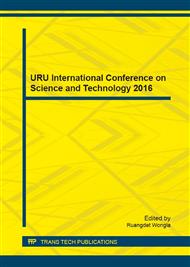[1]
H. Y. Hwang, Y. Iwasa, M. Kawasaki, B. Keimer, N. Nagaosa, and Y. Tokura, Emergent phenomena at oxide interfaces, Nature Materials 11 (2012) 103-113.
DOI: 10.1038/nmat3223
Google Scholar
[2]
T. Kimura, T. Goto, H. Shintani, K. Ishizaka, T. Arima, and Y. Tokura, Magnetic control of ferroelectric Polarization, Nature Materials 426 (2003) 55-58.
DOI: 10.1038/nature02018
Google Scholar
[3]
K. H. Ahn, X. W. Wu, K. Liu, and C. L. Chien, Magnetic properties and colossal magnetoresistance of La(Ca)MnO3 materials doped with Fe, Physical Review B 26 (21) (1996) 299-302.
Google Scholar
[4]
J. G. Bednorz and K. A. Muller, Perovskite-type oxides: The new approach to high-Tc superconductivity, Reviews Modern Physics 60 (1988) 585-600.
Google Scholar
[5]
G. Kim, D. Mazumdar, and A. Gupta, Nanoscale electroresistance properties of all-oxide magneto-electric tunnel junction with ultra-thin barium titanate barrier, Applied Physics Letters 102 (2013) 052908.
DOI: 10.1063/1.4791699
Google Scholar
[6]
W. Meevasana, P. D. C. King, R. H. He, S-K. Mo, M. Hashimoto, A. Tamai, P. Songsiriritthigul, F. Baumberger and Z-X. Shen, Creation and control of a two-dimensional electron liquid at the bare SrTiO3 surface, Nature Materials 10 (2011) 114-118.
DOI: 10.1038/nmat2943
Google Scholar
[7]
P. D. C. King, R. H. He, T. Eknapakul, P. Buaphet, S. -K. Mo, Y. Kaneko, S. Harashima, Y. Hikita, M. S. Bahramy, C. Bell, Z. Hussain, Y. Tokura, Z. -X. Shen, H. Y. Hwang, F. Baumberger and W. Meevasana, Subband structure of a two-dimensional electron gas formed at the polar surface of the strong spin-orbit perovskite KTaO3, Physics Review Letters 108 (2012).
DOI: 10.1103/physrevlett.108.117602
Google Scholar
[8]
S. Suwanwong, T. Eknapakul, Y. Rattanachai, C. Masingboon, S. Rattanasuporn, R. Phatthanakun, H. Nakajima, P.D.C. King, S.K. Hodak and W. Meevasana, The dynamics of ultraviolet-induced oxygen vacancy at the surface of insulating SrTiO3 (001), Applied Surface Science 355 (2015).
DOI: 10.1016/j.apsusc.2015.06.171
Google Scholar
[9]
Y. Aiura, I. Hase, H. Bando, T. Yasue, T. Saitoh, and D.S. Dessau, Photoemission study of the metallic state of lightly electron-doped SrTiO3, Surface Science 515 (2002) 61-74.
DOI: 10.1016/s0039-6028(02)01784-3
Google Scholar
[10]
A. Ohtomo, and H. Y. Hwang, A high-mobility electron gas at the LaAlO3/SrTiO3 heterointerface, Nature Materials 427 (2004) 423-426.
DOI: 10.1038/nature02308
Google Scholar
[11]
C. Masingboon, T. Eknapakul, S. Suwanwong, P. Buaphet, H. Nakajima, S. K. Mo, P. Thongbai, P. D. C. King, S. Maensiri and W. Meevasana, Anomalous change in dielectric constant of CaCu3Ti4O12 under violet-to-ultraviolet irradiation, Applied Physics Letters 102 (2013).
DOI: 10.1063/1.4807741
Google Scholar
[12]
P. Jaiban, S. Suwanwong, O. Namsar, A. Watcharapasorn and W. Meevasana, Simultaneous tuning of the dielectric property and photo-induced conductivity in ferroelectric Ba0. 7Ca0. 3TiO3 via La doping, Materials Letters 147 (2015) 29–33.
DOI: 10.1016/j.matlet.2015.01.114
Google Scholar


